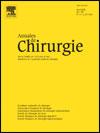Oesophagectomie mini-invasive : évaluation prospective de la gastrolyse coelioscopique - 01/01/06
 , I. Honigman, P. Cattan, E. Sarfati
, I. Honigman, P. Cattan, E. SarfatiRésumé |
Buts. – L'oesophagectomie est une intervention morbide, essentiellement du fait de complications respiratoires. En chirurgie digestive, les suites opératoires sont habituellement améliorées par un abord mini-invasif. Une étude prospective a été initiée pour évaluer la faisabilité et les suites opératoires de l'oesophagectomie mini-invasive (OMI).
Patients et méthodes. – De juillet 2001 à juin 2004, 20 patients ont eu une oesophagectomie avec gastrolyse coelioscopique (GC) pour cancer épidermoïde (n=11), adénocarcinome (n=7), dysplasie de haut grade sur endobrachyoesophage (n=1), et sténose peptique longue (n=1). Les tumeurs (n=19) étaient localisées sur le cardia (n=5), les tiers inférieur (n=10), moyen (n=3), et proximal (n=1). Après GC, une oesophagectomie transthoracique (n=19) ou transhiatale (n=1) était effectuée.
Résultats. – Toutes les GC ont été terminées sans conversion. La durée moyenne des GC était de 197±48 minutes. Sur 19 patients opérés pour tumeur, 18 ont eu une résection R0. Onze patients (55 %) ont développé des complications, surtout respiratoires (30 %). Une fistule anastomotique est survenue chez deux patients, d'évolution favorable. La seule complication intra-abdominale était un pylorospasme. Un patient (5 %) est décédé.
Conclusion. – L'oesophagectomie avec GC est faisable avec peu de complications spécifiques. Cependant, aucune diminution de morbidité globale n'était observée. D'autres études sont nécessaires pour évaluer si la thoracoscopie pourrait améliorer les résultats de la GC et valider l'OMI sur le plan oncologique.
Il testo completo di questo articolo è disponibile in PDF.Abstract |
Objective. – Esophagectomy carries high morbidity, mainly due to respiratory complications. In digestive surgery, postoperative outcome is generally improved by minimally invasive surgery. A prospective study was conducted to evaluate feasibility and postoperative outcome of minimally invasive esophagectomy (MIE).
Methods. – From July 2001 to June 2004, 20 patients underwent esophagectomy with laparoscopic gastric mobilization (LGM) for squamous cell carcinoma (N=11), adenocarcinoma (N=7), Barrett's esophagus with high-grade dysplasia (N=1), and long peptic stricture (N=1). Tumours (N=19) were located on the cardia (N=5), on the lower third of the oesophagus (N=10), on the median third (N=3), and on the upper third (N=1). Following LGM, transthoracic (N=19) or transhiatal (N=1) oesophagectomy was performed.
Results. – Complete LGM was achieved in all cases. Mean operative time for LGM was 197±48 minutes. In the 19 patients operated for tumours, 18 underwent R0 resection. Eleven patients (55%) developed postoperative complications, mainly (30%) respiratory. Intrathoracic anastomotic leakage occurred in 2 patients, with favourable outcome. Pylorospasm (N=1) was the only intraabdominal complication. One patient died (5%).
Conclusion. – Esophagectomy with LGM is feasible with few specific complications. However, no decrease in morbidity could be observed with this technique. Further studies are required to evaluate if thoracoscopy could improve the postoperative course after LGM and to validate oncologic safety of MIE.
Il testo completo di questo articolo è disponibile in PDF.Mots clés : Oesophagectomie, Coelioscopie, Cancer de l'oesophage, Morbidité, Mortalité
Keywords : Esophagectomy, Laparoscopy, Esophageal cancer, Morbidity, Mortality
Mappa
Vol 131 - N° 3
P. 189-193 - Marzo 2006 Ritorno al numeroBenvenuto su EM|consulte, il riferimento dei professionisti della salute.

